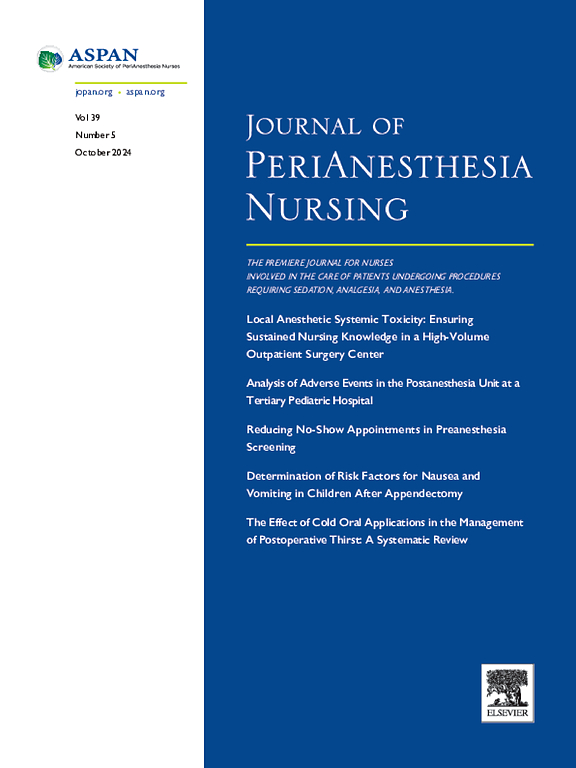Effect of Short-term Deep Breathing Exercises on Perioperative Anxiety and Pain in Pediatric Orthopedic Patients: A Randomized Controlled Trial
IF 1.6
4区 医学
Q2 NURSING
引用次数: 0
Abstract
Purpose
There are currently no pediatric studies examining the effects of deep breathing on perioperative pain and anxiety. This study sought to determine the effect of short-term deep breathing exercises on perioperative anxiety and pain in pediatric patients and their parents.
Design
A randomized controlled trial was conducted in the Department of Orthopaedic Surgery where pediatric patients about to undergo surgery were allocated to a control group or a deep breathing group. In the intervention group, patients and their main guardian were guided to practice 10 minutes of deep breathing exercises twice a day for 3 to 4 days prior to surgery. Perioperative anxiety and pain were measured for both the children and parents as outcome indicators.
Methods
Perioperative anxiety was measured using the modified Yale Preoperative Anxiety Scale-Short Form (mYPAS-SF) and state anxiety was measured using the State-Trait Anxiety Inventory (STAI). Patients reported their pain levels daily using the Wong-Baker FACES Pain Rating Scale. The following cutoffs were determined as high levels of anxiety: STAI (adult) > 44, STAI (child) > 36, and mYPAS-SF ≥ 30.
Findings
No significant differences were found in the STAI, mYPAS-SF, and Wong-Baker FACES Pain Rating Scale scores of the patients between the intervention and control group. Overall statistics showed that parents had significantly higher postoperative state anxiety levels toward female children (44.93 ± 9.01) compared to male children (40.18 ± 9.89). Preoperative and postoperative parental state anxiety levels were correlated with the child’s postoperative anxiety. Furthermore, children’s postoperative state anxiety was slightly correlated with postoperative pain.
Conclusions
Short-term use of our deep breathing exercises was ineffective in reducing incidences of perioperative pain and anxiety in pediatric orthopedic patients. A longer period of deep breathing administration may be required for the intervention to be effective. Parental anxiety may have an effect on anxiety levels in children, and postoperative parental anxiety may be affected by the gender of the child.
短期深呼吸练习对小儿骨科患者围手术期焦虑和疼痛的影响:随机对照试验
目的:目前还没有儿科研究探讨深呼吸对围术期疼痛和焦虑的影响。本研究旨在确定短期深呼吸练习对小儿患者及其家长围手术期焦虑和疼痛的影响:设计:在骨科手术部进行了一项随机对照试验,即将接受手术的小儿患者被分配到对照组或深呼吸组。在干预组中,指导患者及其主要监护人在手术前 3 到 4 天进行深呼吸练习,每天两次,每次 10 分钟。围术期焦虑和疼痛是衡量儿童和家长的结果指标:围手术期焦虑使用改良的耶鲁大学术前焦虑量表-简表(mYPAS-SF)进行测量,状态焦虑使用状态-特质焦虑量表(STAI)进行测量。患者每天使用 Wong-Baker FACES 疼痛评分量表报告其疼痛程度。以下分界点被确定为高度焦虑:STAI(成人)> 44,STAI(儿童)> 36,mYPAS-SF≥ 30:干预组和对照组患者的 STAI、mYPAS-SF 和 Wong-Baker FACES 疼痛评分量表得分无明显差异。总体统计结果显示,与男性患儿(40.18 ± 9.89)相比,女性患儿家长的术后状态焦虑水平(44.93 ± 9.01)明显更高。术前和术后家长的状态焦虑水平与儿童的术后焦虑水平相关。此外,儿童的术后状态焦虑与术后疼痛略有相关:结论:短期使用我们的深呼吸练习无法有效降低小儿骨科患者围手术期疼痛和焦虑的发生率。可能需要更长时间的深呼吸练习才能使干预有效。父母的焦虑可能会影响儿童的焦虑水平,术后父母的焦虑可能会受到儿童性别的影响。
本文章由计算机程序翻译,如有差异,请以英文原文为准。
求助全文
约1分钟内获得全文
求助全文
来源期刊

Journal of Perianesthesia Nursing
NURSING-
CiteScore
2.20
自引率
17.60%
发文量
279
审稿时长
90 days
期刊介绍:
The Journal of PeriAnesthesia Nursing provides original, peer-reviewed research for a primary audience that includes nurses in perianesthesia settings, including ambulatory surgery, preadmission testing, postanesthesia care (Phases I and II), extended observation, and pain management. The Journal provides a forum for sharing professional knowledge and experience relating to management, ethics, legislation, research, and other aspects of perianesthesia nursing.
 求助内容:
求助内容: 应助结果提醒方式:
应助结果提醒方式:


